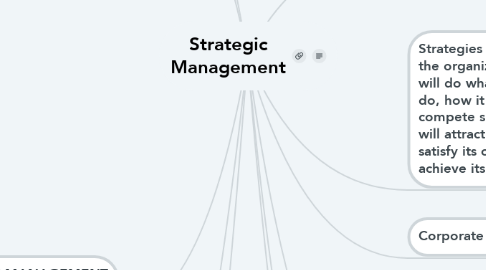Strategic Management
by Austin Rasmussen

1. Business model – how a company is going to make money. It focuses on two things:
2. THE THREE-LEGGED STOOL MODEL
2.1. Market Opportunity External Analysis: - Environmental Scan - Industry / Market Analysis - Competitive Benchmarking
2.2. Resources Internal Analysis: - Value Chain Analysis - Capability Assessment
2.3. Execution Strategy Implementation: - Incentives, Control Systems - Organization Structure
3. THE STRATEGIC MANAGEMENT PROCESS
3.1. Step 1: Identifying the organization’s current mission, goals, and strategies
3.2. Step 2: Doing an External Analysis – The Environmental Scanning of specific and general environments (e.g. economic, demographic, political / legal, sociocultural, technological, and global components to see the trends and changes).
3.3. Step 3: Doing an Internal Analysis – Assessing organizational resources, capabilities, and activities: • Strengths create value for the customer and strengthen the competitive position of the firm. • Weaknesses can place the firm at a competitive disadvantage.
3.4. Step 4: Formulating strategies – Develop and evaluate strategic alternatives. – Select appropriate strategies for all levels in the organization that provide relative advantage over competitors. – Match organizational strengths to environmental opportunities. – Correct weaknesses and guard against threats
3.5. Step 5: Implementing strategies – Implementation – effectively fitting organizational structure and activities to the environment. – The environment dictates the chosen strategy; effective strategy implementation requires an organizational structure matched to its requirements.
3.6. Step 6: Evaluating results – How effective have strategies been at helping the organization reach its goals? – What adjustments, if any, are necessary?
4. TYPES OF CORPORATE STRATEGIES
4.1. Growth – expansion into new products and/or markets served. Stability – maintenance of the status quo. Renewal – examination of organizational weaknesses that are leading to performance declines.
5. Competitive strategy – an organizational strategy for how an organization will compete in its business(es)
5.1. Competitive advantage – what sets an organization apart; its distinctive edge.
5.2. Cost leadership strategy – when an organization competes on the basis of having the lowest costs (costs or expenses, not prices) in its industry. A low-cost leader is highly efficient. Overhead is kept to a minimum, and the firm does everything it can to cut costs
5.3. Differentiation strategy – a company that competes by offering unique products that are widely valued by customers. Product differences might come from exceptionally high quality, extraordinary service, innovative design, technological capability, or an unusually positive brand image
5.4. Focus strategy – involves a cost advantage (focused lowcost) or a differentiation advantage (differentiation focus = Niche) in a narrow segment or niche. Segments can be based on product variety, customer type, distribution channel, or geographical location.
5.5. Stuck in the middle – when costs are too high to compete with the low-cost leader or when its products and services are not differentiated enough to compete with the differentiator.
6. what managers do to develop the organization’s strategies
7. Strategies – the plans for how the organization will do what it’s in business to do, how it will compete successfully, and how it will attract and satisfy its customers in order to achieve its goals.
8. Corporate strategy
8.1. an organizational strategy that determines what businesses a company is in or wants to be in, and what it wants to do with those businesses.
9. FIVE FORCES MODEL Five forces determine industry attractiveness and profitability:
9.1. 1. Threat of new entrants: How likely is it that new competitors will come into the industry? 2. Threat of substitutes: How likely is it that other industries’ products are available for consumers to purchase instead of our industry’s products? 3. Bargaining power of buyers: How much bargaining power do buyers (customers) have? 4. Bargaining power of suppliers: How much bargaining power do suppliers have? 5. Current rivalry: How intense is the rivalry among current industry competitors?
10. Functional Strategy
10.1. the strategies used by an organization’s various functional departments to support the competitive strategy
11. STRATEGIC LEADERSHIP
11.1. the ability to anticipate, envision, maintain flexibility, think strategically, and work with others in the organization to initiate changes that will create a viable and valuable future for the organization.


